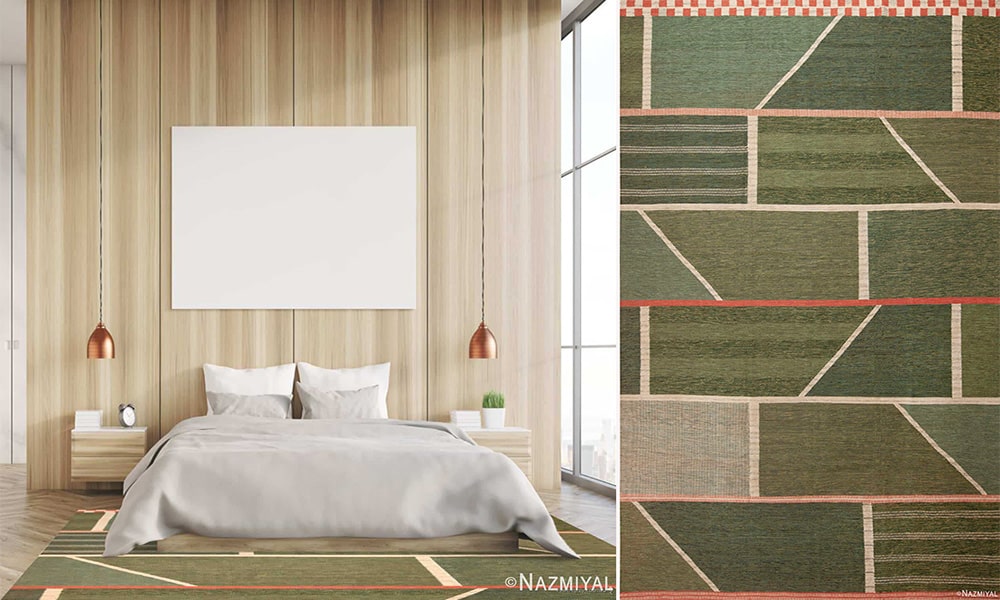How To Choose The Perfect Bedroom Rugs
Shop All Antique Rugs | Shop All Vintage Rugs | Shop All Modern Rugs | Create Your Very Own Unique Custom Rugs
Embarking on the journey of selecting the ideal bedroom rug? Join us as we unravel the art of choosing the perfect bedroom rugs, where comfort, style, and functionality harmonize to create a sanctuary tailored to your unique tastes and needs. From selecting the right size to exploring textures and patterns, let’s delve into the essential tips and tricks to elevate your bedroom space with the perfect rug.
What is the most important aspect of a bedroom rug?
The most important aspect of a bedroom rug depends on individual preferences and needs.
Here are some key considerations when shopping for a bedroom rug:
- Size: The size of the rug is crucial to ensure it fits the dimensions of the room and complements the furniture arrangement. Ideally, a bedroom rug should be large enough to extend beyond the sides of the bed, providing a soft surface for your feet when you get out of bed. Learn more: How To Position and Place Rugs in Rooms
- Material: Choose a material that suits your lifestyle and comfort preferences. Common materials for bedroom rugs include wool, cotton, synthetic fibers, or a blend of these. Wool is often prized for its softness and durability, while synthetic materials may be more affordable and easier to clean.
- Pile Height: The pile height refers to the length of the fibers on the rug’s surface. A higher pile can provide a softer feel underfoot but may require more maintenance and can trap allergens. A lower pile is generally easier to clean and may be a better choice for those with allergies.
- Style and Design: The aesthetic appeal of the rug should complement the overall decor of the bedroom. Consider factors such as color, pattern, and texture to ensure the rug enhances the visual appeal of the space.
- Maintenance: Consider the ease of cleaning and maintaining the rug. Rugs in bedrooms are prone to spills, stains, and daily wear, so it’s important to choose a rug that can be easily cleaned and maintained.
- Comfort: If comfort is a priority, opt for a rug with a soft and plush feel. This can add a cozy touch to the bedroom and make it more comfortable to walk on.
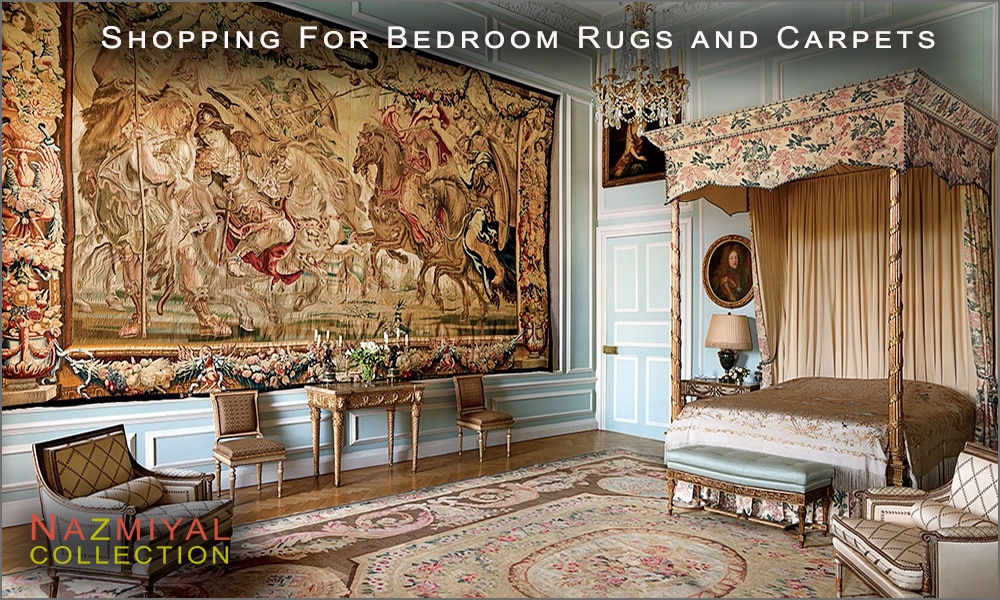
Shopping For Bedroom Rugs and Carpets
Ultimately, the most important aspect of a bedroom rug is how well it suits your personal preferences, complements the overall design of the room, and meets your practical needs in terms of rug size, rug making materials and maintenance.
Why do people use a rug in a bedroom?
People use rugs in bedrooms for various reasons, and the decision is often influenced by both practical and aesthetic considerations.
Here are some common reasons why people use rugs in bedrooms:
- Comfort and Warmth: Rugs provide an additional layer of softness underfoot, making the bedroom more comfortable, especially when getting out of bed in the morning. In colder climates, rugs can also add warmth to a room by providing insulation against cold floors.
- Aesthetics and Style: Rugs are a versatile way to enhance the overall aesthetic appeal of a bedroom. They come in various colors, patterns, and textures, allowing individuals to express their personal style and complement the bedroom’s decor.
- Noise Reduction: Rugs can help absorb sound, reducing the impact of footsteps and other noises. This can be particularly beneficial in bedrooms, creating a quieter and more peaceful atmosphere conducive to relaxation and sleep.
- Define and Anchor Space: Rugs can define specific areas within a bedroom, such as the space around the bed or a seating area. They act as visual anchors, tying together different elements of the room and creating a cohesive design.
- Protection of Floors: Rugs can protect the flooring beneath them from wear and tear. In high-traffic areas or under heavy furniture, a rug can act as a buffer, preventing scratches and damage to the floor.
- Personalization: Adding a rug is an easy way to personalize a bedroom. Whether it’s a luxurious, plush rug for a cozy feel or a vibrant, patterned rug for a pop of color, the choice of a rug can reflect the individual’s personality and taste.
- Hygiene and Cleanliness: Rugs can help keep the bedroom cleaner by trapping dust and debris, preventing them from spreading around the room. Regular vacuuming and cleaning of the rug contribute to a healthier indoor environment.
- Transition and Flow: Rugs can be used to create a sense of transition or delineate different zones within a bedroom. For example, placing a rug at the foot of the bed can visually separate the sleeping area from a seating or dressing area.

Bedroom Layout With Rug Positioned With Most of The Rug Under The Bed
In summary, people use rugs in bedrooms for a combination of practical and aesthetic reasons, ranging from comfort and warmth to style and personalization. The choice of a rug can significantly impact the overall look and feel of the bedroom space.
Should you put a rug under your bed?
Whether or not to put a rug under your bed depends on your personal preferences and the overall design of your bedroom.
Here are some considerations to help you decide weather to put an area rug under the bed:
- Aesthetic Appeal: Placing a rug under the bed can enhance the visual appeal of the bedroom. It can act as a focal point, grounding the bed within the space and adding a layer of design to the room.
- Comfort: A rug under the bed provides a soft surface underfoot, especially when getting out of bed in the morning. This can contribute to a more comfortable and cozy feel in the bedroom.
- Warmth: If you have hardwood or tile floors, a rug can add warmth to the room by providing insulation against cold surfaces. This can be particularly beneficial in colder climates.
- Defining the Space: A rug can help define the sleeping area within the larger bedroom space. This is especially useful in open-concept bedrooms or if you have a large room with multiple functions.
- Protection: Placing a rug under the bed can protect the flooring from wear and tear, especially in high-traffic areas. It acts as a buffer, preventing scratches and damage to the floor.

Bedroom Layout With Rug Positioned Under The Entire Bed and Night Stands
When deciding on the size and placement of a rug under the bed, consider the following tips:
- Size: Choose a rug size that extends beyond the sides and foot of the bed. This creates a balanced look and provides a soft area to step onto when getting out of bed.
- Placement: You can either place the rug entirely under the bed or have it extend beyond the foot of the bed, creating a partial rug under the bed. The latter option is often chosen for aesthetic reasons.
- Symmetry: If you have a larger rug that extends on both sides of the bed, ensure that there is equal spacing on each side for a symmetrical look.

Bedroom Layout With 2 Small Runner Rugs Positioned On Either Side Of The Bed
At the end of the day, the decision to put a rug under your bed depends on your personal style, comfort preferences, and the overall design goals for your bedroom. Experiment with different rug sizes and placements to find the arrangement that suits your taste and enhances the overall look and feel of your bedroom.
More about incorporating area rugs in a bedroom
Adding an area rug to a bedroom provides a whole host of wonderful benefits! Incorporating antique rugs or vintage carpets is a great way to make a statement about one’s personality while adding some style to their room.
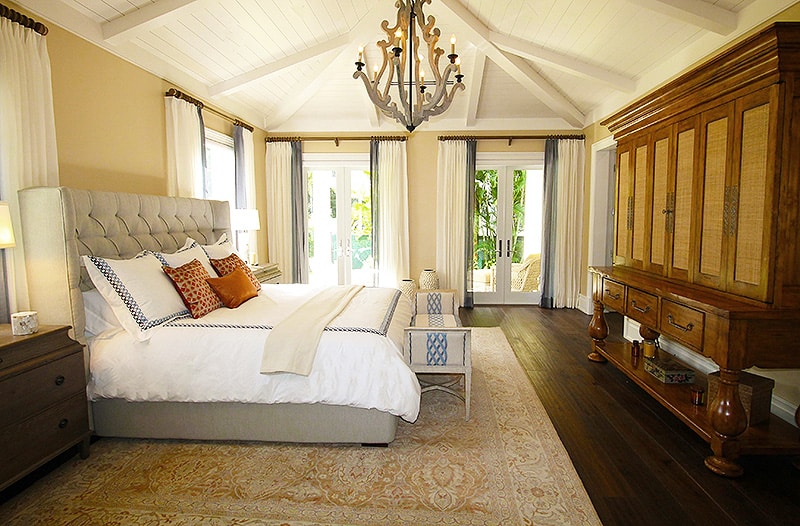
Bedroom Area Rug Interiors
Besides, area rugs in the bedroom offer some functional benefits as well:
- If the bedroom is upstairs an area rug makes a great sound buffer in order to keep the neighbors downstairs happy.
- An area can be used to hide scratches, scuff marks, or accidental stains.
- A nice area rug can provide warmth below foot when first stepped upon on those cold mornings.
- An area rug can be used to break up a room, creating a more personal and intimate areas and settings.
An area rug can tie other stylistic choices in a room together and gives the impression of completeness. An area rug is great, if not for any other reason than to protect the floor from potential damage.

Casual Bedroom Decor With Layered Navajo Rugs
Before going out and buying a rug, it’s important that one determines what they want out of a rug in order to get the best “bang for their buck”.
Where is the best position for a bedroom rug?
The placement of a bedroom rug can vary depending on factors such as the size of the room, the layout, and the overall design aesthetic you want to achieve.
Here are a few more common positions for a bedroom rug:
- Under the bed: Placing a rug partially or fully under the bed is a popular choice. You can position the rug in a way that extends beyond the sides and/or the foot of the bed. This creates a soft and cozy surface for your feet when getting in and out of bed. It also helps anchor the bed visually and adds a layer of warmth and texture to the space.
- Along the sides of the bed: If you have a smaller rug or prefer a different aesthetic, you can position the rug alongside the bed, running parallel to the sides. This creates a runner-like effect and can work well in narrow bedrooms or when you want to showcase more of the flooring.
- Centered in the room: In larger bedrooms or rooms with a spacious layout, you may choose to center the rug in the middle of the room, away from the bed. This can create a designated seating or dressing area, and the rug can be paired with furniture like chairs, ottomans, or a vanity.
You should make sure that you consider the size of the rug, the dimensions of the room and the placement of other furniture when determining the best position for your bedroom rug.
Experimenting with different rug sizes and placements can help you find the bedroom arrangement that suits your space and design preferences the most.
How To Choose The Right Size Rug For Your Bedroom?
After a spot has been chosen for the bed, it is important that the overall “cover-able” space is measured so that the right rug size may be purchased. At a minimum, the length and width of the area where the rug is going to be laid down should be measured and noted.
If it is decided that the rug should cover the area around and beneath a bed, it is a good idea to measure – not just the bed but also the length and width of the extending floor around the bed. This will enable you to figure out the absolute minimum and maximum rug size range that you could potentially use in the bedroom.

Medallion Rug Bedroom
For a larger size bedroom where there is also space for amenities such as a desk, vanity, or seating arrangements, small area rugs can be used to section off and create different spaces in the bedroom with great effect. This approach will break up the bedroom into different areas and will give the bedroom a more open feel.
If the bedroom is on the smaller side, such as a room where there is not enough space for anything other than a bed, a large size rug, placed under and around the bed, may look better. This approach will tie in the room and make it feel more on the cozy intimate side rather than just a small size bedroom.
In general, what are the more popular bedroom area rug sizes?
Popular bedroom rug sizes can vary depending on factors such as the size of the room, the layout, and personal preferences.
Here are some commonly used rug sizes for bedrooms:
- 5′ x 8′ or 6′ x 9′: These sizes are versatile and work well in average-sized bedrooms. They provide enough coverage around the bed area and allow for furniture placement around the rug.
- 8′ x 10′ or 9′ x 12′: These larger rug sizes are suitable for spacious bedrooms or master bedrooms. They offer more coverage, extending beyond the bed area and accommodating additional furniture like seating areas or dressers.
- 9′ x 12′ or 10′ x 14′: These sizes are commonly chosen for larger bedrooms or master suites with ample floor space. They provide a generous amount of coverage, creating a luxurious and cohesive look in the room.
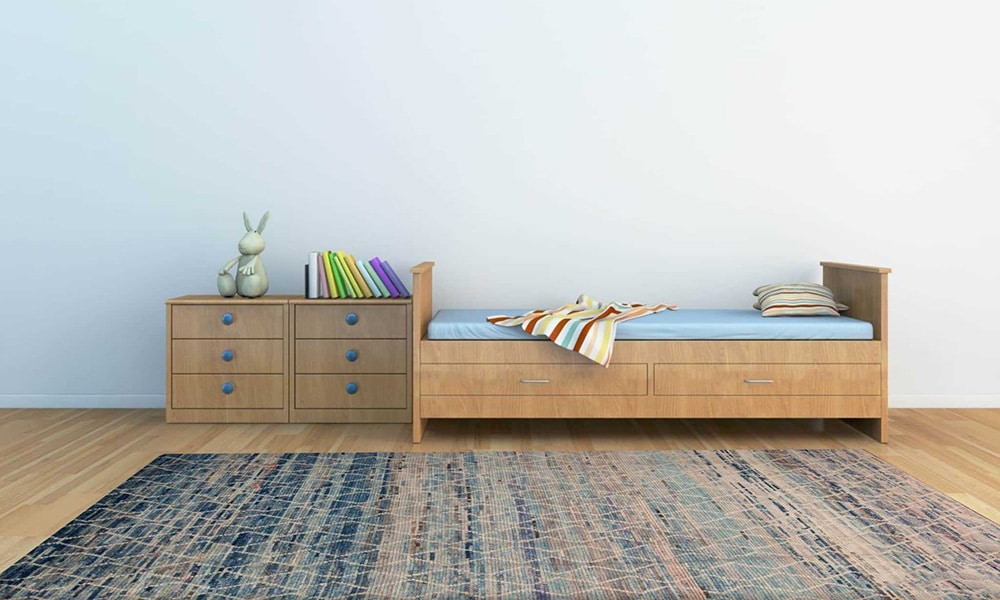
Bedroom Interior With Light Blue Abrash Modern Area Rug #11282
Remember that these are general guidelines, and you should consider your specific room dimensions, furniture layout, and personal preferences when selecting a rug size for your bedroom. It’s always a good idea to measure your space and visualize how different rug sizes would fit and complement your bedroom design.
What size area rug do I need for a queen size or a king size bed?
A common guideline to choose a bedroom area rug size is to select a rug that will extends at least 2 to 3 feet (61 to 91 cm) beyond each side of the bed.
The general guideline with regards to the rug size you need for under the bed is:
Rug Size For A King Size Bed:
A standard king-size bed typically measures about 76 inches (193 cm) wide and 80 inches (203 cm) long. Based on the guideline mentioned above, you would ideally want a rug that is approximately 10 feet (305 cm) wide and 12 feet (366 cm) long to accommodate the size of the bed and provide a balanced look in the room.
Rug Size For A Queen Size Bed:
A standard queen-size bed typically measures about 60 inches (152 cm) wide and 80 inches (203 cm) long. Following the guideline mentioned above, you would ideally want a rug that is approximately 8 to 9 feet (244 to 274 cm) wide and 10 to 11 feet (305 to 335 cm) long.
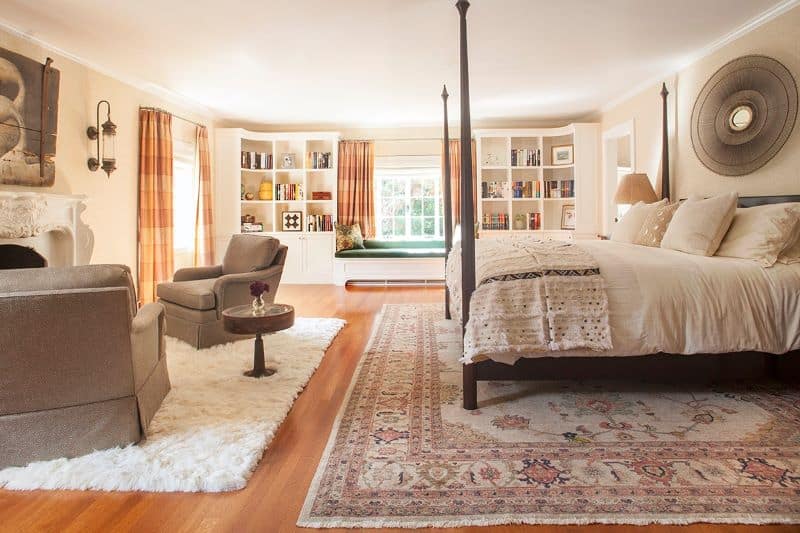
Choose rugs for your bedroom in the right size.
Why do people put rugs under their beds?
People put rugs under their beds for several reasons, including aesthetic, functional, and practical considerations.
Here are a few reasons why people choose to place rugs under their beds:
- Aesthetic enhancement: Placing a rug under the bed can enhance the overall aesthetic appeal of the bedroom. It adds an extra layer of texture, color, and pattern, helping to anchor the bed visually and create a focal point in the room. The rug can complement the style and design theme of the bedroom, adding warmth and visual interest to the space.
- Comfort and softness: Stepping onto a soft rug when getting out of bed in the morning can provide a more comfortable and cozy experience. Rugs provide an additional layer of cushioning underfoot compared to hard flooring or carpeting. It can be especially beneficial if the bedroom has hard floors or the carpeting is not particularly plush.
- Noise reduction: Rugs can help absorb sound and reduce noise transmission in the bedroom. If you have hardwood or tile floors, a rug under the bed can help minimize the noise of footsteps, furniture movement, or other sounds, providing a quieter and more peaceful environment for sleep.
- Warmth and insulation: In colder climates or during winter months, placing a rug under the bed can provide insulation and help keep the floor warmer. It acts as a barrier between your feet and the cold floor, making the bedroom more comfortable and cozy.
- Define the sleeping area: Placing a rug under the bed can visually define the sleeping area within the bedroom. It creates a designated space for the bed, making it feel more intentional and organized. This can be particularly useful in open-concept or large bedrooms where defining specific zones is desired.
Ultimately, the decision to put a rug under the bed is a personal preference based on the desired style, comfort, and functionality in the bedroom. It’s important to choose a rug size and design that complements the bed, the room layout, and your individual preferences.
How To Pick Area Rug Style To Complete the Bedroom Decor?
There are literally hundreds of different area rug styles, looks and rug colors to choose from. Making a bedroom selection is all about showcasing one’s personal taste and style. If the bedroom is heavily decorated with pictures and brightly patterned comforters, a more toned down rug might be a wise choice to contrast with the more “busy” surroundings.
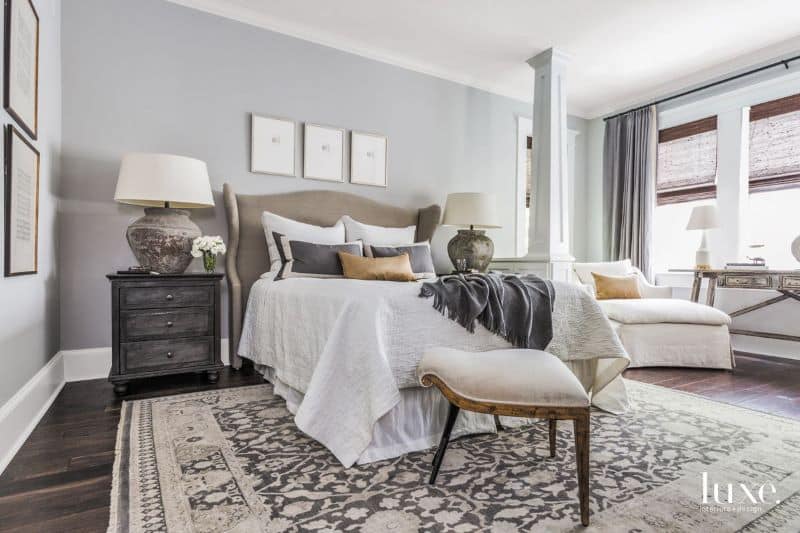
Oushak Carpet In A Bedroom
If the furniture deign and bedding in the bedroom are all in solid or more neutral colors, a more lively patterned bedroom rug may be just the thing to set the room off. Oriental rugs with patterns such as Paisley designs make great choices in this instance.
How To Select Bedroom Rugs Made From The Best Materials For Their Intended Use?
Aside from all the different rug style patterns and color choices available in the market, rugs and carpets also can also be made of a variety of different rug weaving materials. Depending on personal preference, how much traffic the room typically gets and whether or not pets may be involved, different materials may be more beneficial than others.

Classic Oriental Bedroom Rug
Silk rugs look great and can add some excitement to a room but pets and heavy traffic may leave the bedroom rug worse for wear sooner than later. For some more durable options, cotton and wool rugs offer greater durability and offer a much easier cleaning experience.
How To Accessorize Around The Bedroom Rug – Not The Other Way Around
When decorating your bedroom, selecting the appropriate style rug is better done sooner than later. Waiting until all the other stylistic choices and purchases have been made for a bedroom can make shopping for and matching a rug to the style of the room much more difficult. The ideal Bedroom rug should be the first item selected as it will much easier to decorate the room from the floor up rather than visa versa.
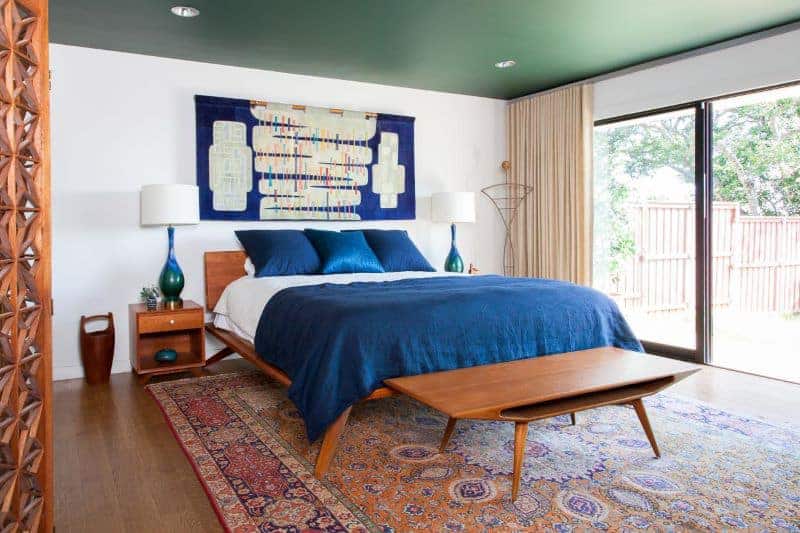
Accessorize around the bedroom rug.
Do people layer an area rug on top of a carpet in their bedroom?
Yes, it is not uncommon for people to place and layer an area rug on top of a carpet in their bedrooms. Adding an area rug on carpet can serve several purposes, such as enhancing the visual appeal of the room, adding extra comfort underfoot, or defining specific areas within the bedroom.
Here are a few reasons why people choose to layer rugs on top of carpet in their bedrooms:
Style and aesthetics: Layering rugs can bring additional colors, patterns, and textures into the room, helping to enhance the overall style and design scheme. It can be an opportunity to introduce a different rug style or shape that complements the existing carpet and decor.
Comfort and warmth: Placing an area rug on top of carpet can add an extra layer of cushioning and softness, providing a more comfortable surface to walk on or sit on. This can be particularly beneficial if the existing carpet is thin or doesn’t provide enough warmth or coziness.
Definition of space: Rugs can help define specific areas within a bedroom. For example, you can place a rug under the bed to create a cozy sleeping zone or position a smaller rug in a seating or dressing area to visually separate that space from the rest of the room.
When layering rugs on carpet, it’s important to choose rugs with appropriate thickness and textures to ensure they lay flat and do not create a tripping hazard. It’s also recommended to use rug pads between the area rug and the carpet to provide stability and prevent slipping.
You may also want to learn more about: Living Room Rugs – Foyer Entryway Rugs – Dining Room Rugs – Family Room Rugs – Boudoir Powder Room Rugs – Sunroom Rugs – Rugs For Kids Rooms – Home Office Rugs – Library Rugs – Kitchen Rugs.

